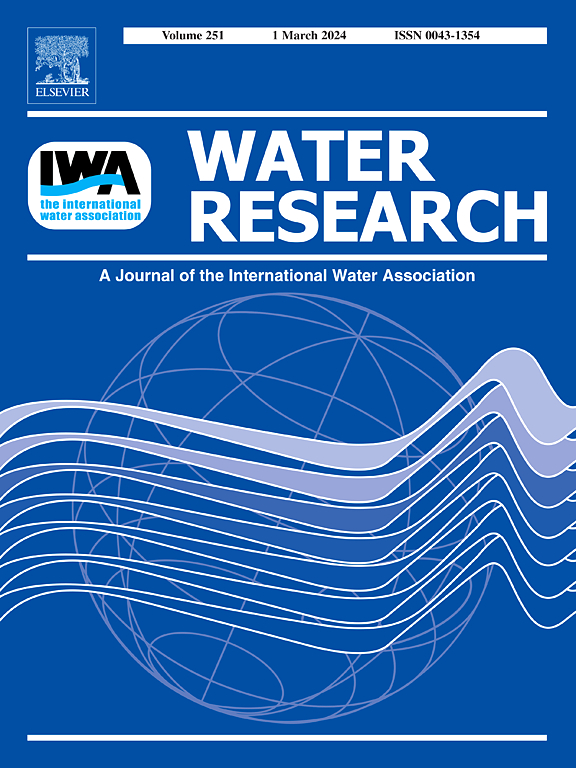Identification, sources and accumulation behavior of priority odorants discharged to surface water from stormwater systems with illicit connections
IF 12.4
1区 环境科学与生态学
Q1 ENGINEERING, ENVIRONMENTAL
引用次数: 0
Abstract
The odor nuisance of urban surface water after rainfall events has aroused public concerns and threaten the aquatic organisms. Herein, the first study to investigate 150 odorants in storm sewer discharge was performed in humid regions of China. During rainfall events, the total concentrations of odorants at storm sewer outlet increased by 1.3-2.1 fold from 1.7-9.4 µg/L to 2.1-20.0 µg/L with 37 odorants having detection frequencies above 50% on rainy days, and the concentrations of total odorants in air also significantly resulting in worse odor nuisance. The accumulation of odorants in sewer sediment and the remobilization of sewer sediment were factors resulting in more intensified emission of odorants from storm sewer on rainy days. More than half of odorants discharged during rainfall were contributed by sewer sediment. Thioethers, indoles, 2-isopropyl-3-methoxy pyrazine, acetophenone and coumarin exhibited high sediment-accumulation. Quantitative structure-property relationship models revealed that enhanced sediment-accumulation of chained aliphatic and aromatic odorants can be explained by the electrostatic attraction and topological characteristic, respectively. The multicriteria analysis was further introduced for relative odorants ranking by considering the variations in hazard criteria of environmental occurrence, ecotoxicity, persistence, odor nuisance and sediment accumulation. Among priority odorants, thioethers and indoles were attributed by their distinct sediment-accumulation and odor nuisance potential, while chlorinated anisole and pinenes prioritized due to their higher ecotoxicity. These findings provide novel insights into the odorants from storm sewer discharges and explore the environmental behaviors of odorants in sewer sediment.

从非法连接的雨水系统排放到地表水的优先气味的识别、来源和积累行为
降雨后城市地表水的气味污染引起了公众的关注,并对水生生物造成了威胁。本文首次对中国潮湿地区雨水下水道排放的150种气味进行了研究。降雨天气下,雨阴沟出水口总气味浓度从1.7 ~ 9.4µg/L增加到2.1 ~ 20.0µg/L,增加了1.3 ~ 2.1倍,有37种气味的检测频率在50%以上,空气中总气味浓度也显著加剧了气味滋扰。恶臭物质在下水道底泥中的积累和底泥的再活化是导致雨天雨水下水道恶臭物质排放加剧的因素。降雨期间排放的气味中有一半以上来自下水道沉积物。硫醚类、吲哚类、2-异丙基-3-甲氧基吡嗪类、苯乙酮类和香豆素类具有较高的沉积积累。定量结构-性能关系模型表明,链式脂肪族和芳香类气味剂的沉积积累增强可以分别用静电吸引和拓扑特性来解释。通过考虑环境发生、生态毒性、持久性、气味滋扰和沉积物积累等危害标准的变化,进一步介绍了多标准分析的相对气味排序方法。其中,硫醚类和吲哚类因其具有明显的沉积和气味滋扰潜力而被优先考虑,而氯化苯甲醚类和蒎烯类因其较高的生态毒性而被优先考虑。这些发现为雨水下水道排放物的气味提供了新的见解,并探索了下水道沉积物中气味剂的环境行为。
本文章由计算机程序翻译,如有差异,请以英文原文为准。
求助全文
约1分钟内获得全文
求助全文
来源期刊

Water Research
环境科学-工程:环境
CiteScore
20.80
自引率
9.40%
发文量
1307
审稿时长
38 days
期刊介绍:
Water Research, along with its open access companion journal Water Research X, serves as a platform for publishing original research papers covering various aspects of the science and technology related to the anthropogenic water cycle, water quality, and its management worldwide. The audience targeted by the journal comprises biologists, chemical engineers, chemists, civil engineers, environmental engineers, limnologists, and microbiologists. The scope of the journal include:
•Treatment processes for water and wastewaters (municipal, agricultural, industrial, and on-site treatment), including resource recovery and residuals management;
•Urban hydrology including sewer systems, stormwater management, and green infrastructure;
•Drinking water treatment and distribution;
•Potable and non-potable water reuse;
•Sanitation, public health, and risk assessment;
•Anaerobic digestion, solid and hazardous waste management, including source characterization and the effects and control of leachates and gaseous emissions;
•Contaminants (chemical, microbial, anthropogenic particles such as nanoparticles or microplastics) and related water quality sensing, monitoring, fate, and assessment;
•Anthropogenic impacts on inland, tidal, coastal and urban waters, focusing on surface and ground waters, and point and non-point sources of pollution;
•Environmental restoration, linked to surface water, groundwater and groundwater remediation;
•Analysis of the interfaces between sediments and water, and between water and atmosphere, focusing specifically on anthropogenic impacts;
•Mathematical modelling, systems analysis, machine learning, and beneficial use of big data related to the anthropogenic water cycle;
•Socio-economic, policy, and regulations studies.
 求助内容:
求助内容: 应助结果提醒方式:
应助结果提醒方式:


